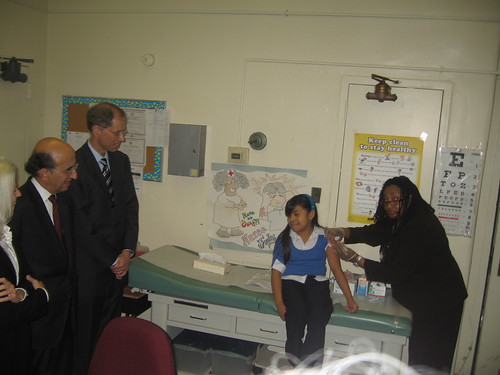In a post on his Atlantic.com blog, David Shenk makes the point that “vaccines have become something of a civic responsibility: they work best when everyone takes them.”
Media reports have continued to highlight the skepticism of many Americans about the H1N1 vaccine. More than half of Utah residents surveyed in a KSL-TV/Deseret News poll said they were planning to skip the vaccination. And the New York Times reported that as of last week, “…fewer than half of New York City parents with children in elementary school have given permission for their children to receive the vaccine at school, reflecting some ambivalence about the need for the vaccine or concern about its effects.”

Every citizen/parent will have to make their own choice on the vaccine. However, as Shenk argues, we all have a stake in each other’s decisions, because the numbers vaccinated will likely have an impact on the flu’s spread. The Times article, written by Jennifer Medina, explains the role of “herd immunity” in dealing with H1N1:
Experts debate exactly what level of flu vaccination is ideal, but a computer model developed several years ago by epidemiologists at Emory University, based on experiences with mandatory flu shots for Japanese schoolchildren, suggested that when 50 percent of children are vaccinated, a community’s risk of a seasonal flu epidemic falls by two thirds, and when 70 percent are vaccinated, the risk drops to 4 percent.
U.S. Homeland Secretary Janet Napolitano has spoken often about the “shared responsibility” of each stakeholder, including the public, when it comes to emergency preparedness and response. However, to date officials have not emphasized that messaging approach yet on the H1N1 vaccinations. Of course, as there is not enough available vaccine it may be premature to make that communications push right now. And, ultimately you want people to get the vaccine, because they believe it is in their own interest. Nevertheless, to help move some Americans off the vaccine fence, I think using the shared or civic responsibility approach might be helpful.




1 response so far ↓
1 Joel // Nov 3, 2009 at 12:54 pm
In discussing the vaccination at work (emergency management agency) and with other people who also have public health backgrounds (I have an MPH) we kept coming back to the lack of ‘herd immunity’ in any of the discussions of vaccination. There are a lot of people I work with who aren’t big fans of getting flu shots (seasonal or H1N1) but after talking about herd immunity they see the value of the shot, even if they “never” get the flu. I really feel that HHS especially have missed an opportunity to encourage wider uptake of the vaccine (ignoring the supply issues) by not pushing this specific aspect of shared responsibility.
Leave a Comment